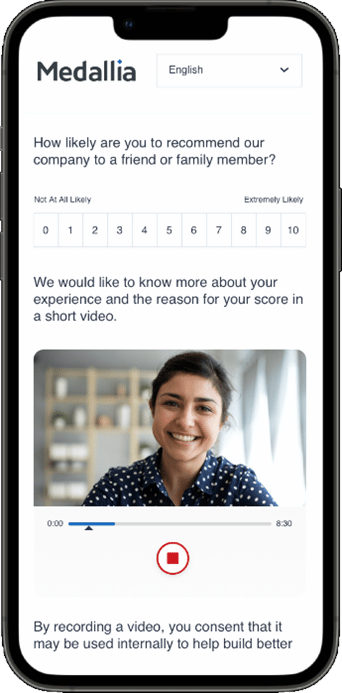Opportunities to provide feedback on a product or experience can be plentiful in terms of the amount of outreach many companies do to stay in touch with their customers and the avenues through which feedback can be provided. Companies are leveraging an ever-growing number of input streams that are supported by a variety of technologies. As the insights and feedback category becomes more technology focused, providers are also realizing that keeping the human aspect of the engagement is critical for both the customer and the consumer of the data.
Feedback Sources and Channels

While in-person feedback channels remain, the majority are now digital with a multitude of technologies supporting them. However, there are a variety of ways that CX technology providers are humanizing the interaction, making the experience more personal, engaging, and user-friendly, while providing higher response rates and more meaningful data to the company collecting the data.
Designing a more appealing feedback user interface (UI) that uses branding, graphics, and language can provide an experience more in line with what a customer might have during an in-person interaction. This approach was discussed in-depth in a recently published interview with David Solana, of OPINATOR, during which Solana mentioned getting 3x to 5x the response rate of other solutions using technology that can be highly personalized and fun to engage with. Likewise, Concentrix reports a lift in response rates as much as 40% by using more cutting-edge survey methods and innovative user experience (UX) design.
Voice audio is another tool used to humanize the experience for customers. With the use of these technologies, “tell us more” is not just an empty text box awaiting someone’s quickly typed response, but could be an opportunity to allow customers to leave their own verbal response, providing a more natural and free-flowing approach that can be analyzed for underlying emotion. Dash Research recently had a demo with Phebi, a provider of voice-driven solutions for quantitative and qualitative research and CX. Phebi is designed to be integrated with other platforms, and the company recently announced a global partnership with Forsta. Phebi’s technology can detect the emotions beyond what is said, leveraging artificial intelligence (AI), machine learning (ML), and social science. The technology checks many different voice characteristics every three seconds to detect the non-conscious emotion behind what is spoken, determining an Emotional Resonance Score. According to Mike Page, CEO at Phebi, “Spoken responses are longer and richer and can better predict behavior. The use of Phebi helps to pick up the nuances in a customer response and provide context. End users of the data can be presented with a variety of scores and reports that identify the emotional states and the intensity of emotions, enabling them to find patterns that they might not otherwise see.” Phebi reports strong end-user acceptance of the technology, with over 50% of those providing feedback choosing to answer by voice, rather than text.
Video is another technology used to humanize the exchange of information and is also seeing positive results when used as an option for feedback. SMG partners with Voxpopme to provide an automated video feedback solution and worked with Co-op on a two-week video feedback pilot designed to provide a more engaging way to communicate with the brand. There were 250 participants in the trial, which helped Co-op yield a 4% video response rate among its key demographics, as well as video responses that were 2x longer than text feedback. Co-op will be expanding the video offering.
Medallia has been offering video and speech channels for feedback natively and considers this a more modern and convenient method of capturing signals. Both the speech and video technologies came to Medallia through 2020 acquisitions and, since that time, the company has further developed both technologies that can integrate with existing technology stacks. The company’s Living Lens video feedback solution uses AI and ML to unearth insights with speech, emotion, object, and context data as inputs.

The use of these solutions results in richer information (there is typically 6x more information given via video feedback than by the equivalent open-ended text response) and a more humanizing experience both for the person giving the feedback and the team reviewing the information. Customers include Just Worldwide, Del Taco, and Renewal by Andersen.
As feedback mechanisms grow even more technology-laden, it will be important to keep the human nature of the customer relationship top of mind. By allowing customers to communicate their feedback in a more natural and easy manner, brands help people be heard and seen in a way they have not been traditionally able to via clicking radio buttons or providing text responses. It also allows the consumers of the data to dig into the emotions of responses, and piece together a more compelling story of the customer’s experience that can be shared with internal stakeholders.
Author Information
As a detail-oriented researcher, Sherril is expert at discovering, gathering and compiling industry and market data to create clear, actionable market and competitive intelligence. With deep experience in market analysis and segmentation she is a consummate collaborator with strong communication skills adept at supporting and forming relationships with cross-functional teams in all levels of organizations.
She brings more than 20 years of experience in technology research and marketing; prior to her current role, she was a Research Analyst at Omdia, authoring market and ecosystem reports on Artificial Intelligence, Robotics, and User Interface technologies. Sherril was previously Manager of Market Research at Intrado Life and Safety, providing competitive analysis and intelligence, business development support, and analyst relations.
Sherril holds a Master of Business Administration in Marketing from University of Colorado, Boulder and a Bachelor of Arts in Psychology from Rutgers University.









